matplotlib: 最流行的Python底层绘图库,主要做数据可视化图表,名字取材于MATLAB,模仿MATLAB构建
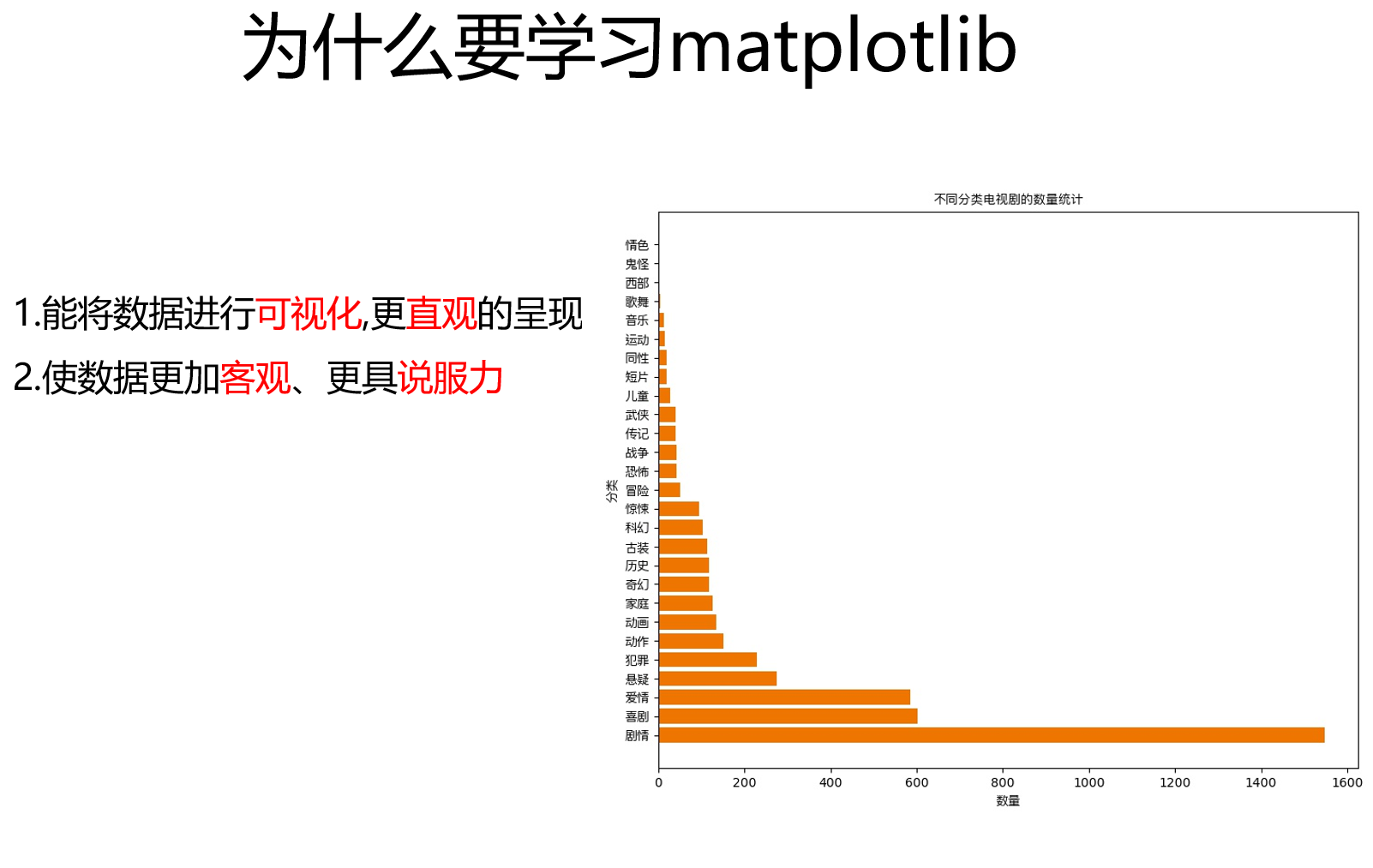
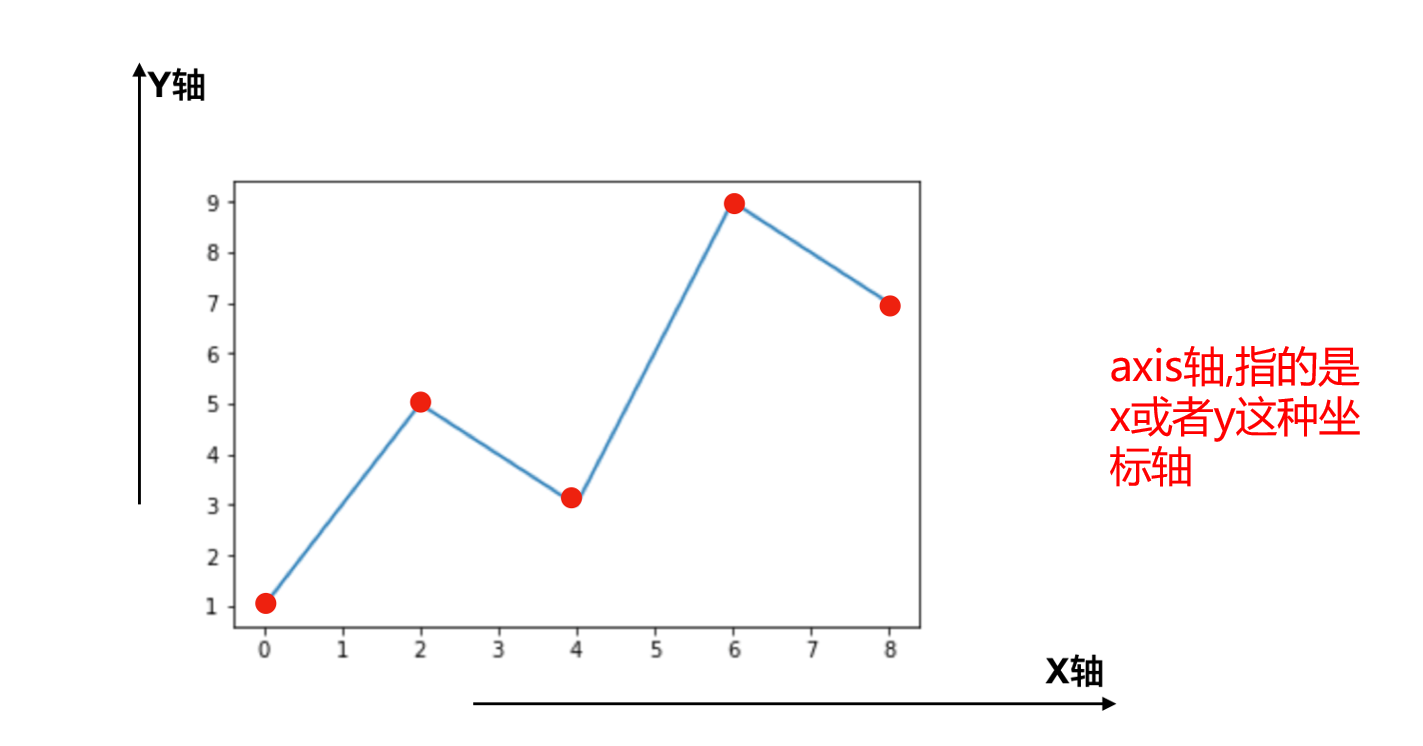
Matplotlib折线图基本要点
折线图的主要应用场景:
• 呈现公司产品(不同区域)每天活跃用户数
• 呈现app每天下载数量
• 呈现产品新功能上线后,用户点击次数随时间的变化
• 呈现员工每天上下班时间
Q:假设一天中每隔两个小时(range(2,26,2))的气温(℃)分别是[15,13,14.5,17,20,25,26,26,27,22,18,15],如何使用matplotlib 模块进行绘图
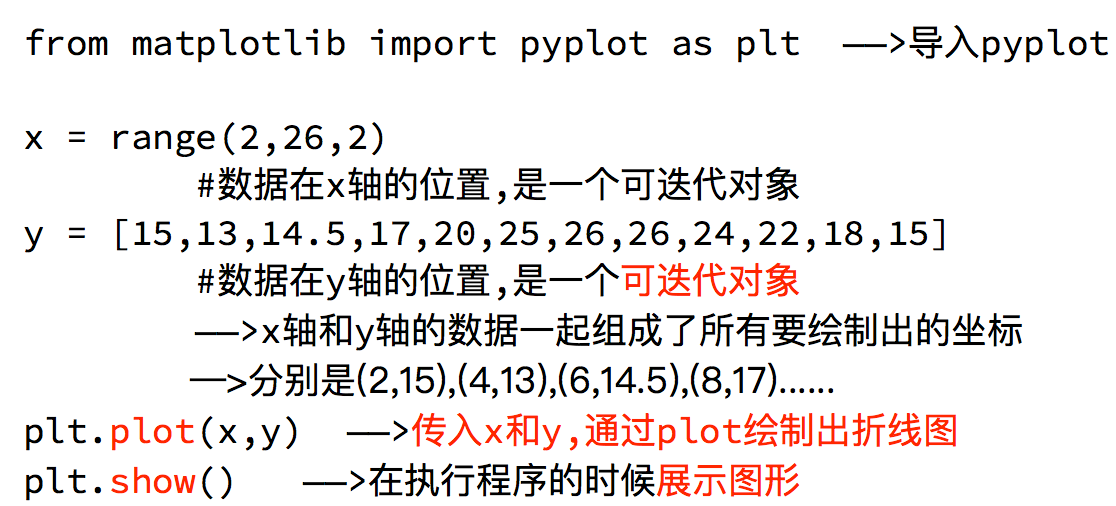
输出内容:
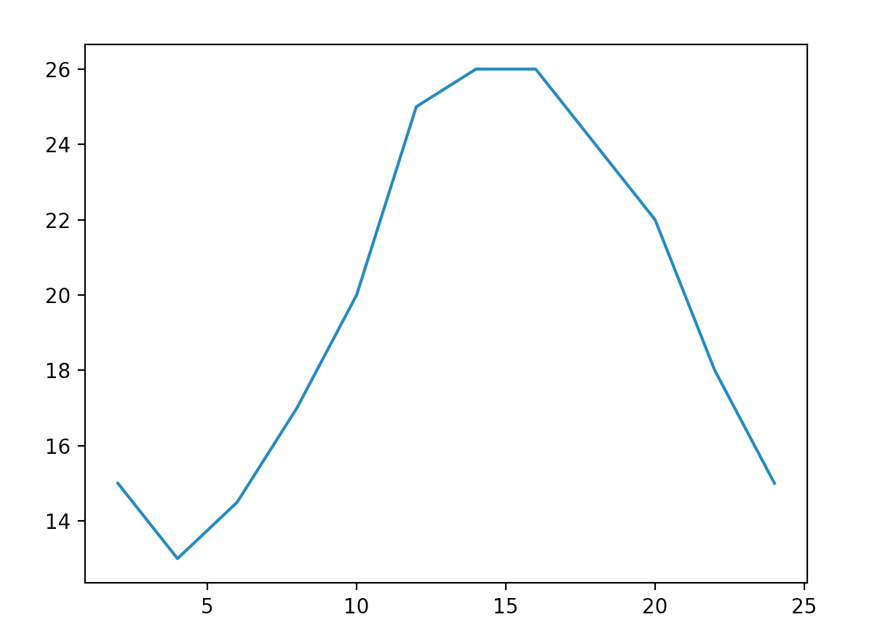
图片过于简易。我们能看明白这个图是什么,但是别人能看不明白,如何增加细节?
matplotlib设置图片大小
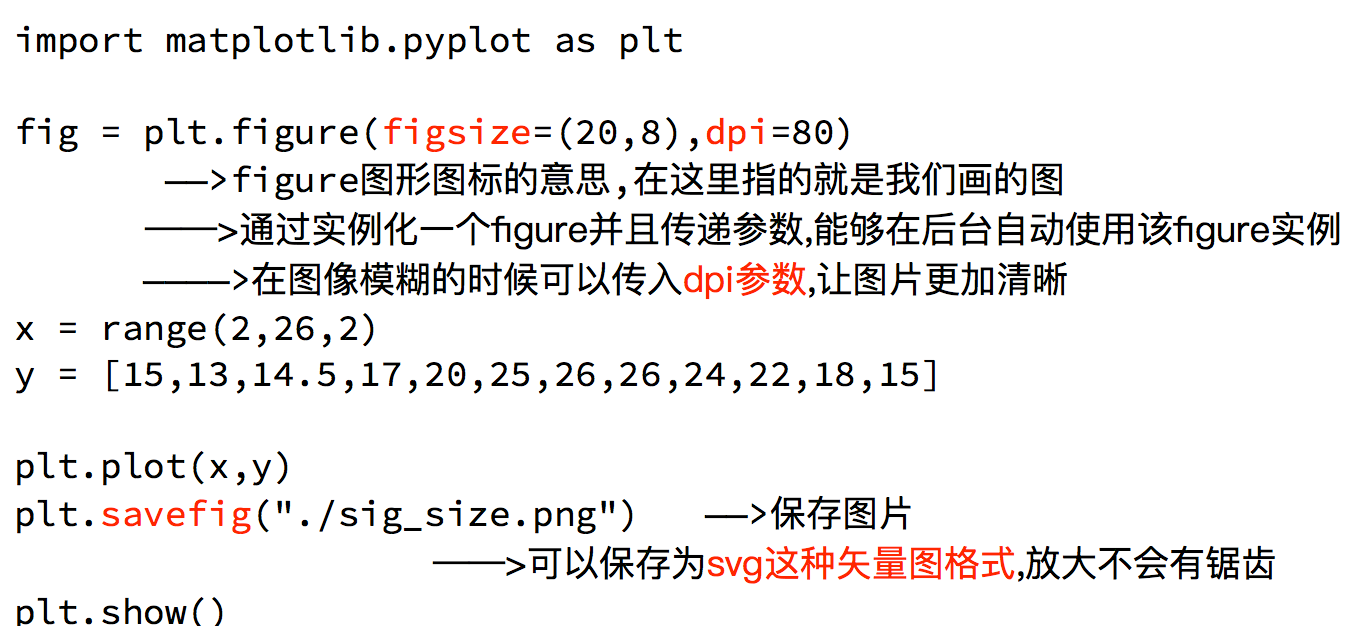
输出内容:
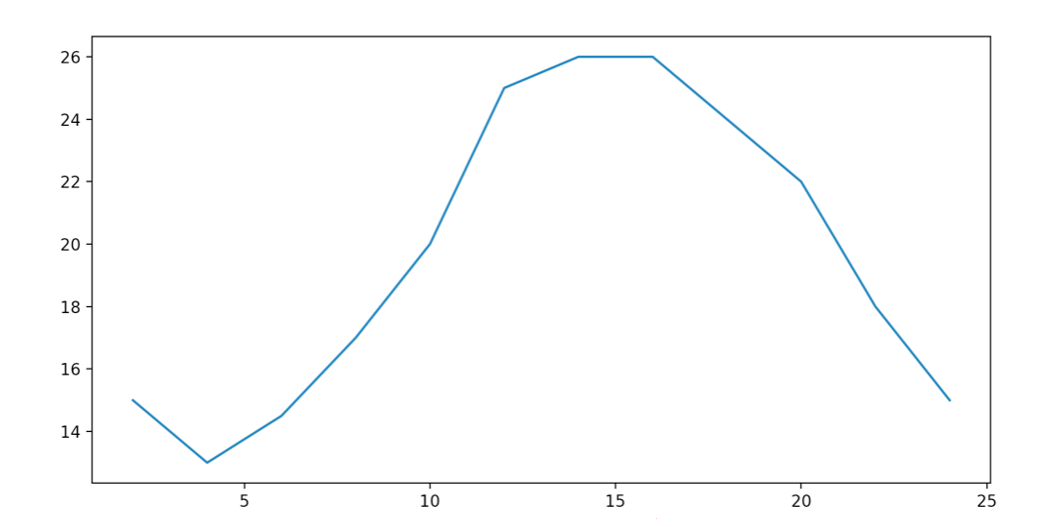
matplotlib调整X或者Y轴上的刻度
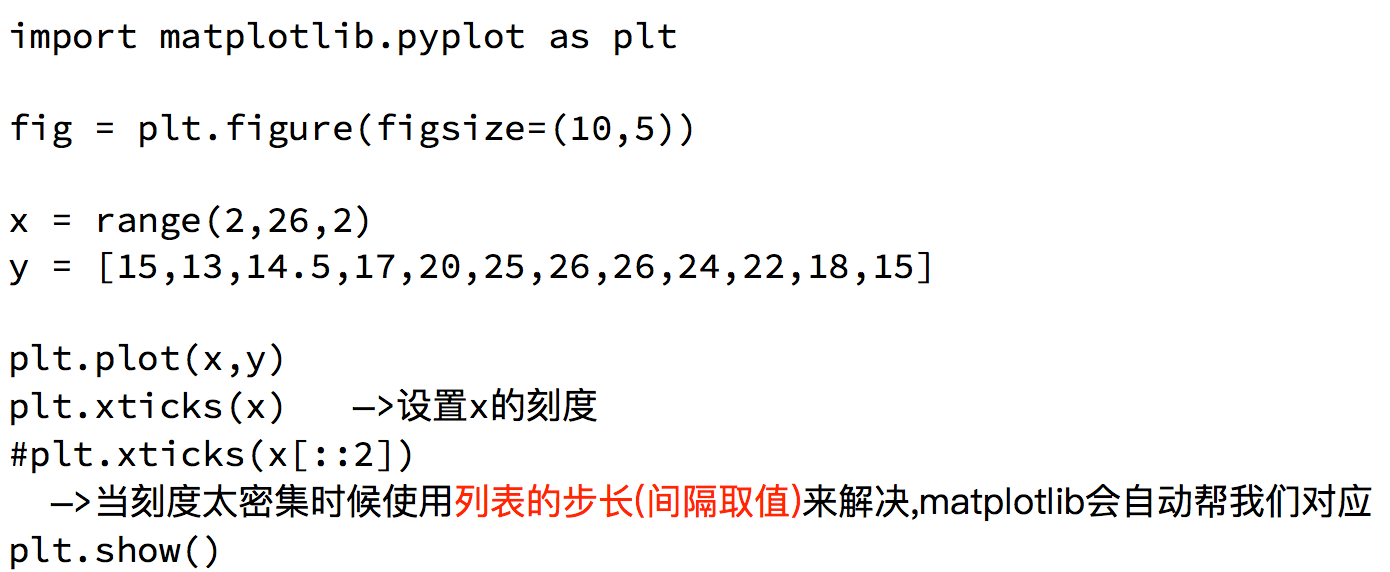
如果列表a表示10点到12点的每一分钟的气温,如何绘制折线图观察每分钟气温的变化情况?
a= [random.randint(20,35) for i in range(120)]生成内容:
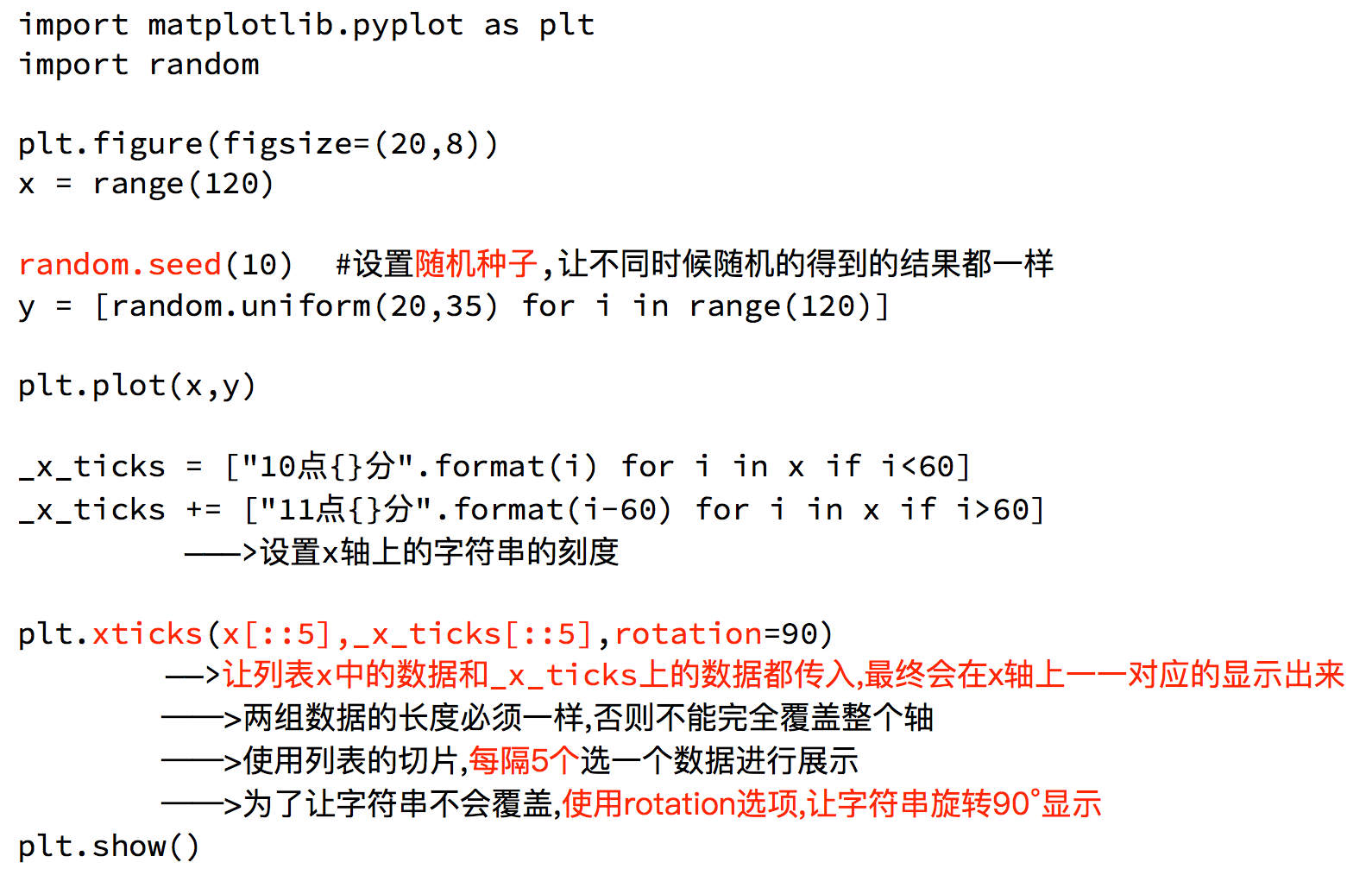
图片下方中文显示乱码,如何让其正常显示?
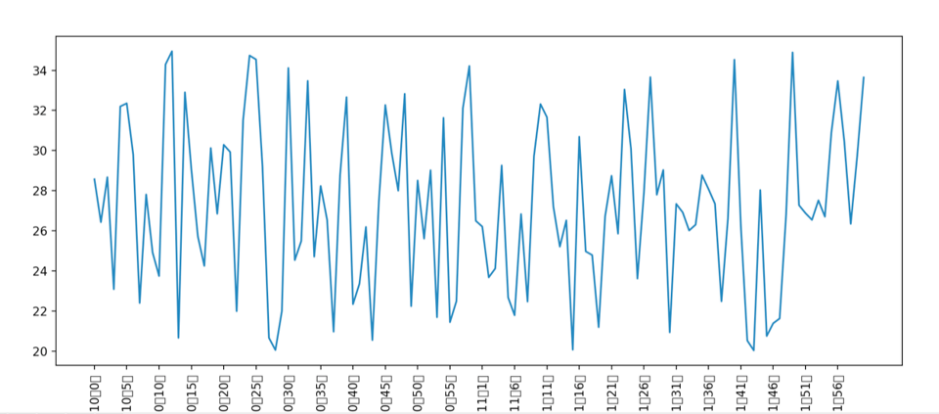
matplotlib设置中文显示
为什么无法显示中文?
matplotlib默认不支持中文字符,因为默认的英文字体无法显示汉字
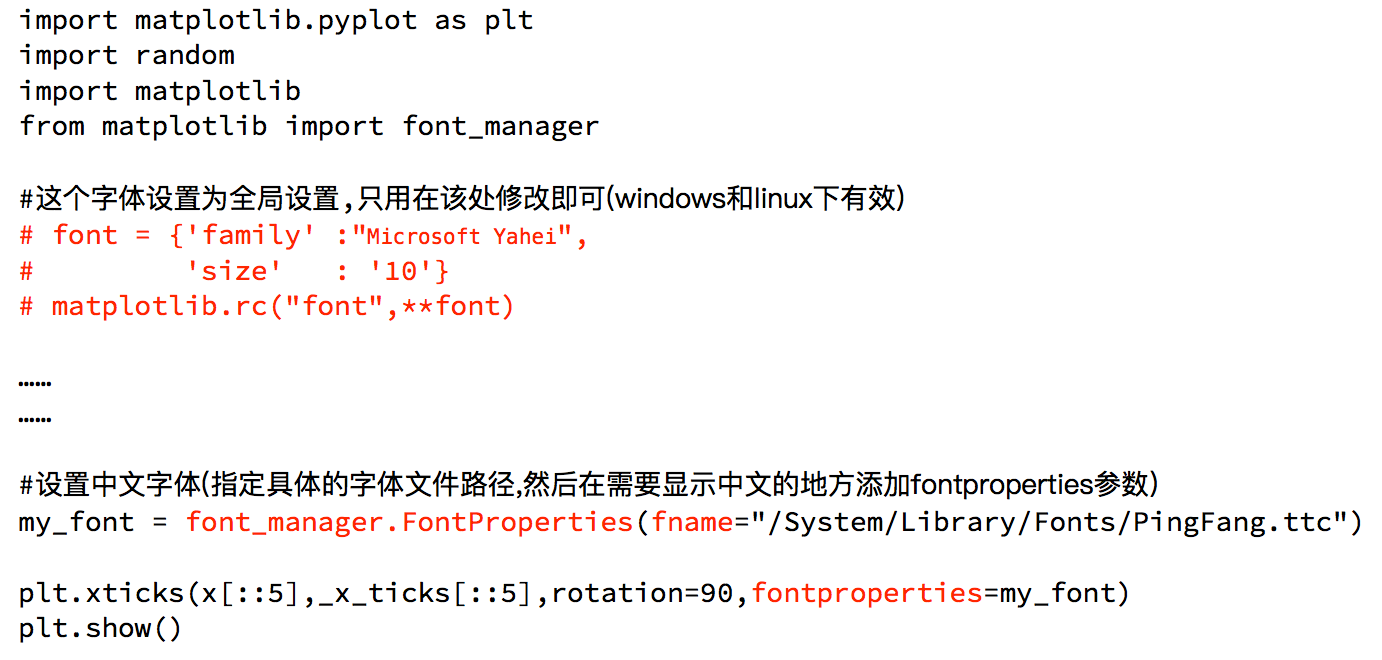
输出内容:
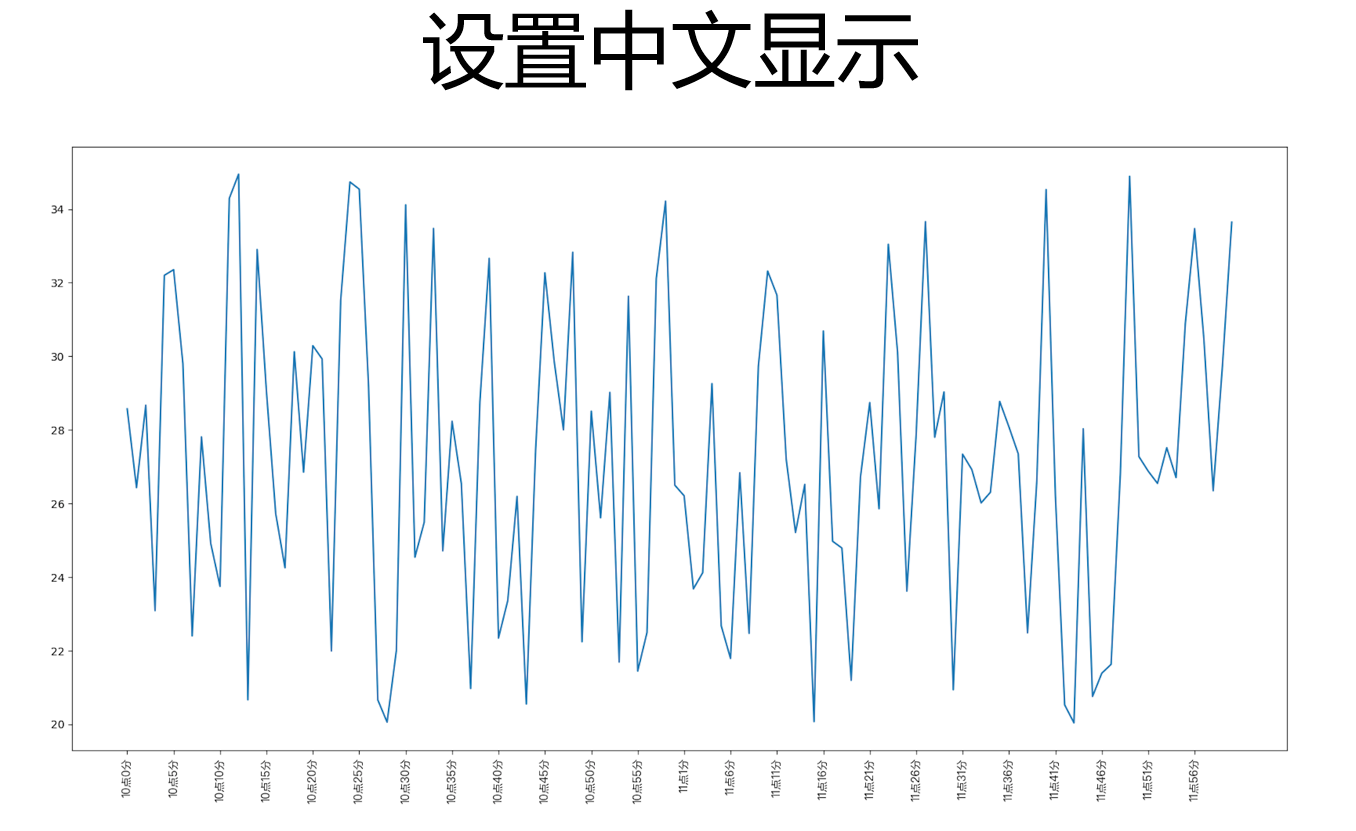
matplotlib给图像添加描述信息

输出内容:
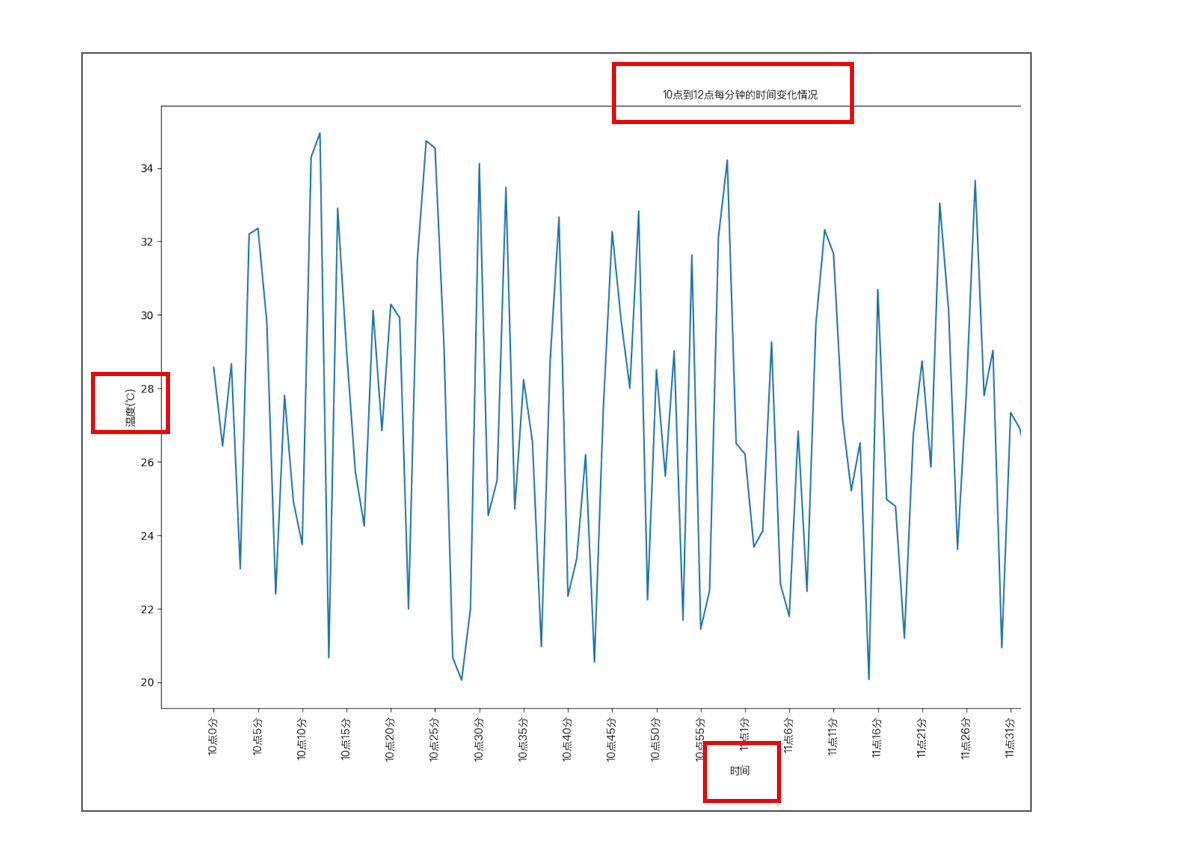
matplotlib自定义绘制图形的风格
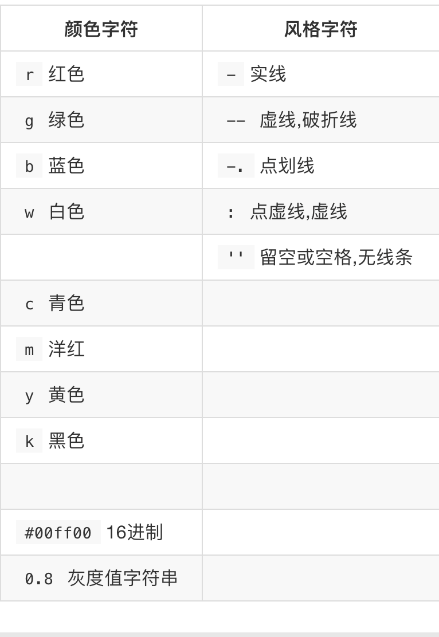
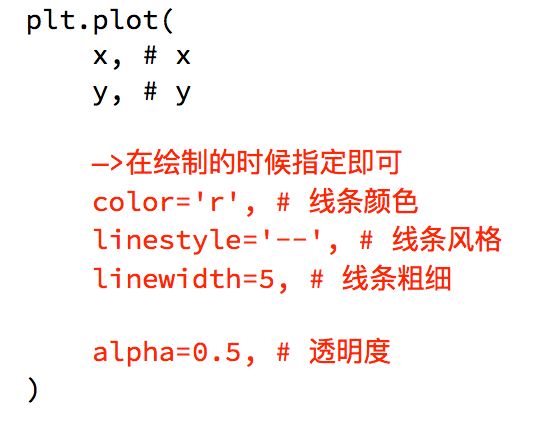
除此之外还可以为每条线添加图例:

matplotlib折线图练习
假设大家在30岁的时候,根据自己的实际情况,统计出来了你和你同桌各自从11岁到30岁每年交的女(男)朋友的数量如列表a和b,请在一个图中绘制出该数据的折线图,以便比较自己和同桌20年间的差异,同时分析每年交女(男)朋友的数量走势
a = [1,0,1,1,2,4,3,2,3,4,4,5,6,5,4,3,3,1,1,1]
b = [1,0,3,1,2,2,3,3,2,1 ,2,1,1,1,1,1,1,1,1,1]
要求: y轴表示个数x轴表示岁数,比如11岁,12岁等
from matplotlib import pyplot as plt
from matplotlib import font_manager
my_fount = font_manager.FontProperties(fname="C:/WINDOWS/FONTS/MSYHL.TTC")
x = range(11, 31)
y = [1, 0, 1, 1, 2, 4, 3, 2, 3, 4, 4, 5, 6, 5, 4, 3, 3, 1, 1, 1]
b = [1, 0, 3, 1, 2, 2, 3, 3, 2, 1, 2, 1, 1, 1, 1, 1, 1, 1, 1, 1]
plt.figure(figsize=(20, 8), dpi=80)
plt.plot(x, y, label="自己",color="orange",linestyle="-.")
plt.plot(x, b, label="同桌",color="cyan",linestyle=":")
_xl = ["{}岁".format(i) for i in x]
plt.xticks(x, _xl, fontproperties=my_fount)
plt.yticks(range(0, 9))
plt.grid(alpha=0.5) #绘制格子(alpha透明度)
plt.legend(prop=my_fount,loc="upper left")
plt.show()
matplotlib更多的可绘制图类型
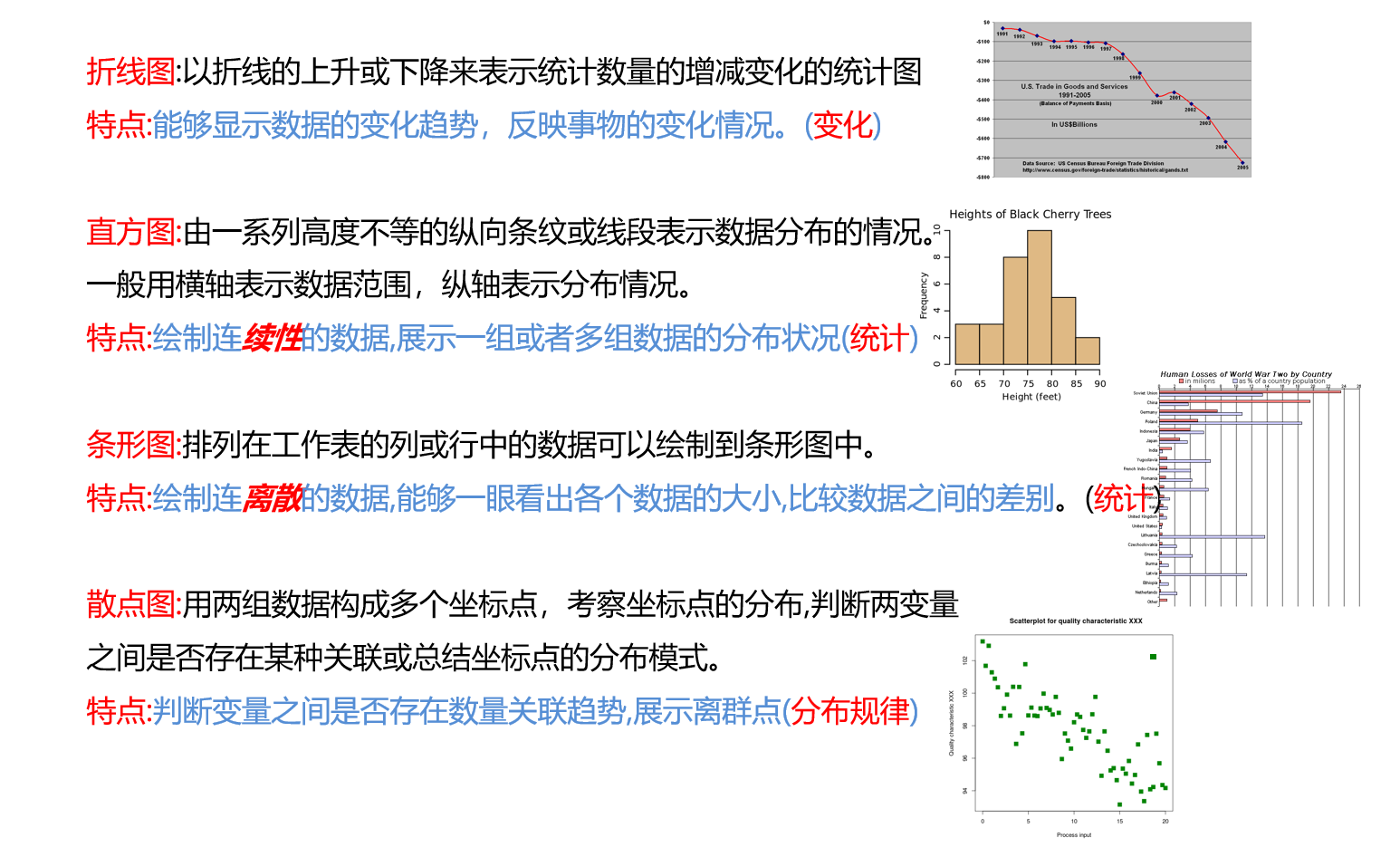
matplotlib散点图绘制
散点图的主要应用场景:
• 不同条件(维度)之间的内在关联关系
• 观察数据的离散聚合程度
Q:假设通过爬虫你获取到了北京2016年3,10月份每天白天的最高气温(分别位于列表a,b),那么此时如何寻找出气温和随时间(天)变化的某种规律?
a = [11,17,16,11,12,11,12,6,6,7,8,9,12,15,14,17,18,21,16,17,20,14,15,15,15,19,21,22,22,22,23]
b = [26,26,28,19,21,17,16,19,18,20,20,19,22,23,17,20,21,20,22,15,11,15,5,13,17,10,11,13,12,13,6]
from matplotlib import pyplot as plt
from matplotlib import font_manager
my_fount = font_manager.FontProperties(fname="C:/WINDOWS/FONTS/MSYHL.TTC")
y_3 = [11,17,16,11,12,11,12,6,6,7,8,9,12,15,14,17,18,21,16,17,20,14,15,15,15,19,21,22,22,22,23]
y_10 = [26,26,28,19,21,17,16,19,18,20,20,19,22,23,17,20,21,20,22,15,11,15,5,13,17,10,11,13,12,13,6]
x_3 = range(1,32)
x_10 = range(51,82)
plt.figure(figsize=(20,8),dpi=80)
plt.scatter(x_3,y_3,color='blue',label = "3月")
plt.scatter(x_10,y_10,color='red',label = "10月")
#调整x
_x = list(x_3) + list(x_10)
_xl = ["3月{}日".format(i) for i in x_3]
_xl += ["10月{}日".format(i-50) for i in x_10]
plt.xticks(_x[::3],_xl[::3],fontproperties=my_fount,rotation=45)
plt.legend(loc='upper right',prop=my_fount)
plt.xlabel("时间",fontproperties=my_fount)
plt.ylabel("温度",fontproperties=my_fount)
plt.title("标题",fontproperties=my_fount)
plt.show()
运行结果:
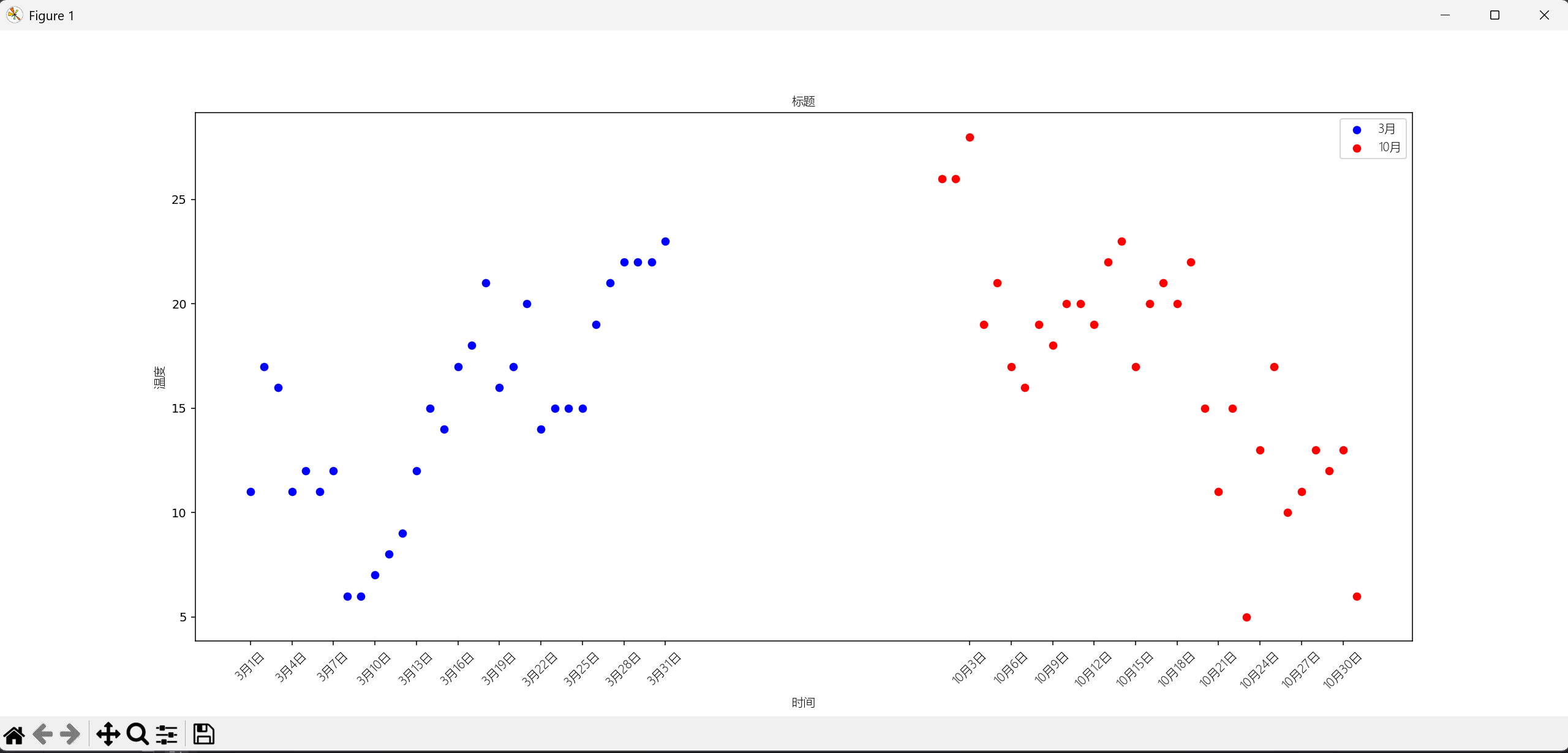
matplotlib条形图绘制
条形图主要的应用场景:
• 数量统计
• 频率统计(市场饱和度)
Q1:假设你获取到了2017年内地电影票房前20的电影(列表a)和电影票房数据(列表b),那么如何更加直观的展示该数据?
a = ["战狼2","速度与激情8","功夫瑜伽","西游伏妖篇","变形金刚5:最后的骑士","摔跤吧!爸爸","加勒比海盗5:死无对证","金刚:骷髅岛","极限特工:终极回归","生化危机6:终章","乘风破浪","神偷奶爸3","智取威虎山","大闹天竺","金刚狼3:殊死一战","蜘蛛侠:英雄归来","悟空传","银河护卫队2","情圣","新木乃伊",]
b=[56.01,26.94,17.53,16.49,15.45,12.96,11.8,11.61,11.28,11.12,10.49,10.3,8.75,7.55,7.32,6.99,6.88,6.86,6.58,6.23] 单位:亿
from matplotlib import pyplot as plt
from matplotlib import font_manager
my_fount = font_manager.FontProperties(fname="C:/WINDOWS/FONTS/MSYHL.TTC")
a = ["战狼2","速度与激情8","功夫瑜伽","西游伏妖篇","变形金刚5:最后的骑士","摔跤吧!爸爸","加勒比海盗5:死无对证","金刚:骷髅岛","极限特工:终极回归","生化危机6:终章","乘风破浪","神偷奶爸3","智取威虎山","大闹天竺","金刚狼3:殊死一战","蜘蛛侠:英雄归来","悟空传","银河护卫队2","情圣","新木乃伊",]
b=[56.01,26.94,17.53,16.49,15.45,12.96,11.8,11.61,11.28,11.12,10.49,10.3,8.75,7.55,7.32,6.99,6.88,6.86,6.58,6.23]
plt.figure(figsize=(20,12),dpi=80)
plt.barh(range(len(a)),b,height=0.3,color="black")
plt.yticks(range(len(a)),a,fontproperties=my_fount)
plt.grid(alpha=0.5)
plt.show()
"""
plt.figure(figsize=(20,12),dpi=80)
plt.bar(range(len(a)),b,width=0.3)
plt.xticks(range(len(a)),a,fontproperties=my_fount,rotation=45)
plt.show()
竖向的条形图
"""
输出内容:
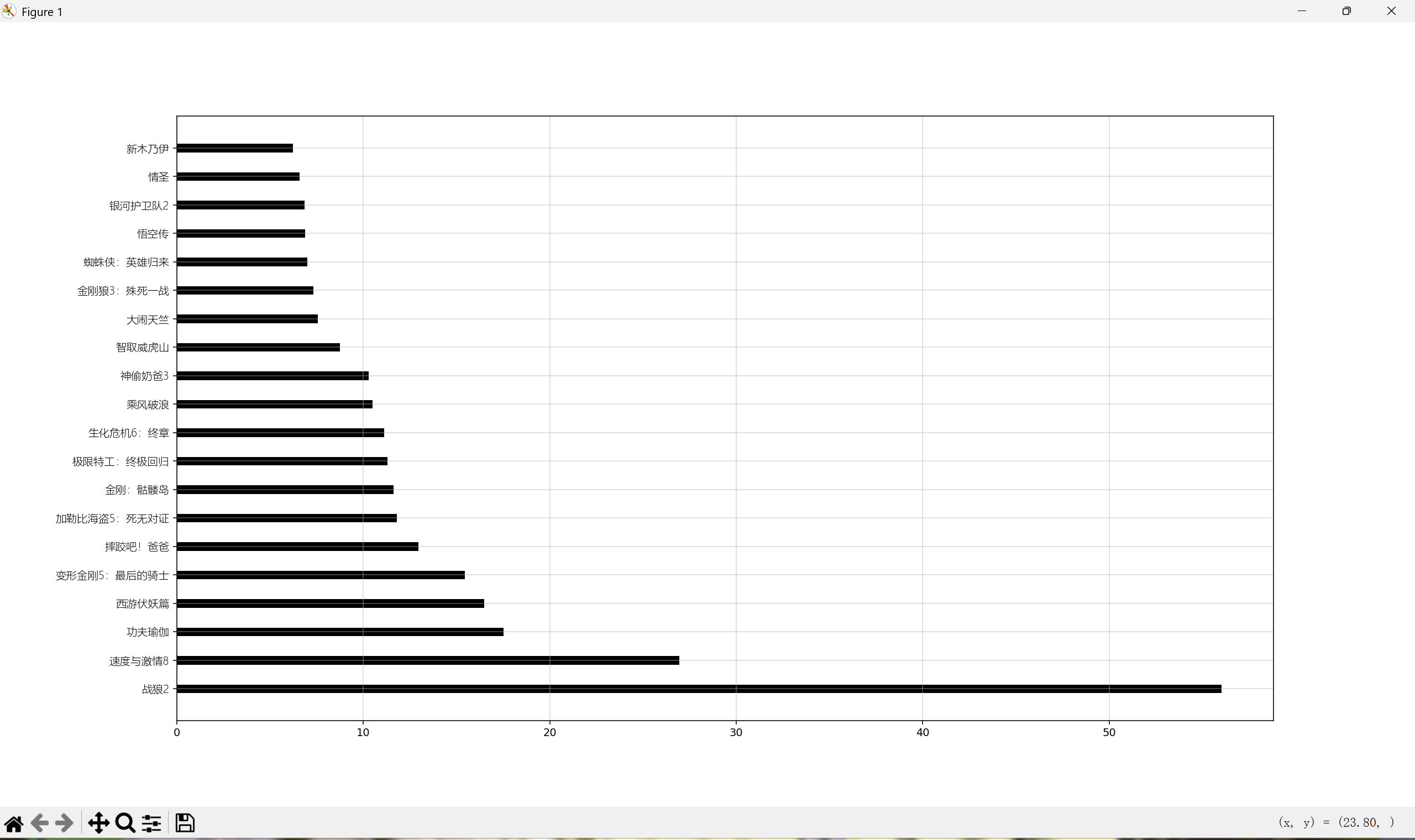
Q2:假设你知道了列表a中电影分别在2017-09-14(b_14), 2017-09-15(b_15), 2017-09-16(b_16)三天的票房,为了展示列表中电影本身的票房以及同其他电影的数据对比情况,应该如何更加直观的呈现该数据?
a = ["猩球崛起3:终极之战","敦刻尔克","蜘蛛侠:英雄归来","战狼2"]
b_16 = [15746,312,4497,319]
b_15 = [12357,156,2045,168]
b_14 = [2358,399,2358,362]
from matplotlib import pyplot as plt
from matplotlib import font_manager
my_fount = font_manager.FontProperties(fname="C:/WINDOWS/FONTS/MSYHL.TTC")
a = ["猩球崛起3:终极之战","敦刻尔克","蜘蛛侠:英雄归来","战狼2"]
b_16 = [15746,312,4497,319]
b_15 = [12357,156,2045,168]
b_14 = [2358,399,2358,362]
bar_width = 0.2
x_14 = list(range(len(b_14)))
x_15 = [i+bar_width for i in x_14]
x_16 = [i+bar_width for i in x_15]
plt.figure(figsize=(20,8),dpi=80)
plt.bar(range(len(a)),b_14,width=bar_width,label="9月14日")
plt.bar(x_15,b_15,width=bar_width,label="9月15日")
plt.bar(x_16,b_16,width=bar_width,label="9月16日")
plt.legend(prop=my_fount)
plt.xticks(x_15,a,fontproperties=my_fount)
plt.show()
输出内容:
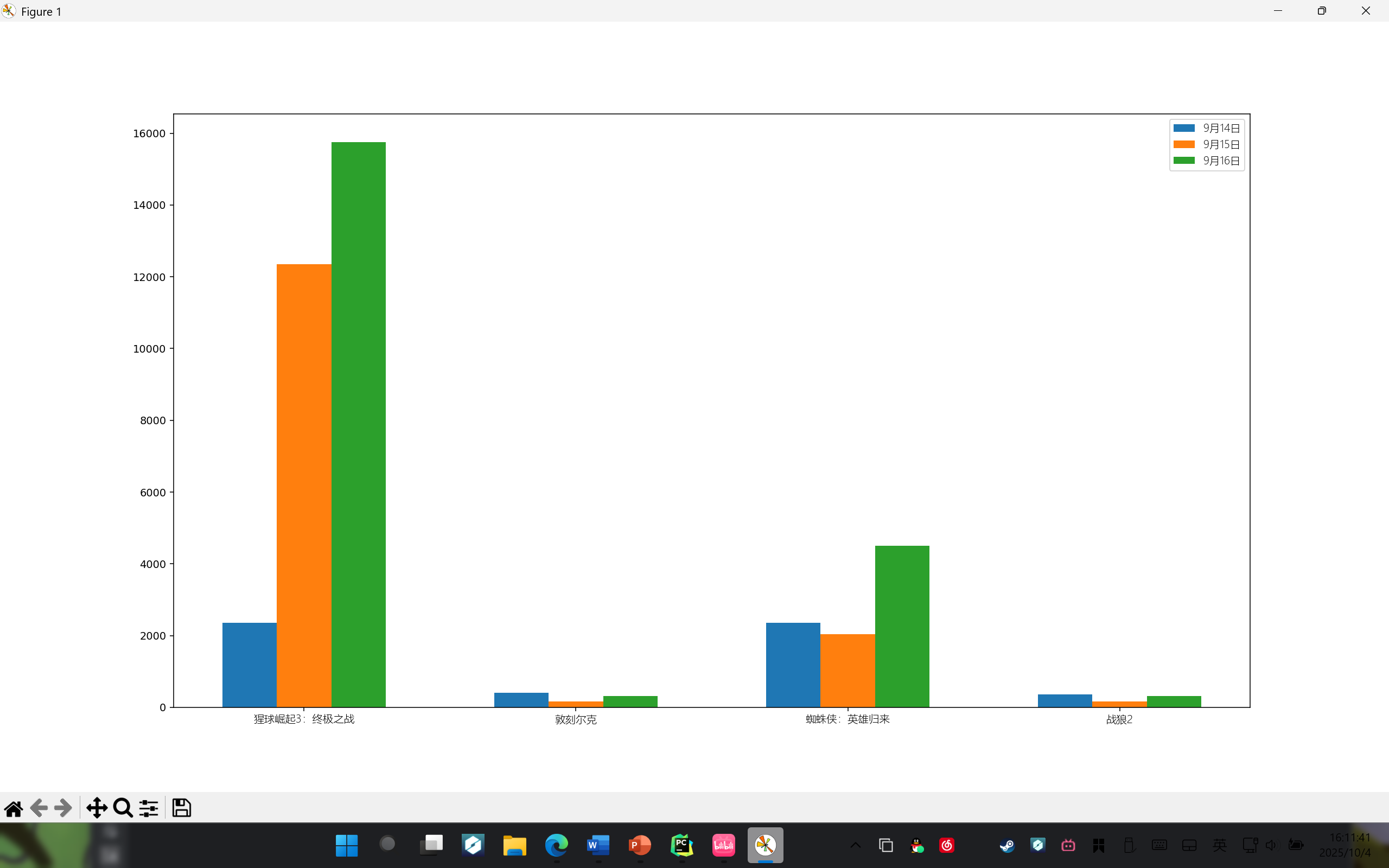
Matplotlib直方图绘制
直方图主要的应用场景:
• 用户的年龄分布状态
• 一段时间内用户点击次数的分布状态
• 用户活跃时间的分布状态
Q : 假设你获取了250部电影的时长(列表a中),希望统计出这些电影时长的分布状态(比如时长为100分钟到120分钟电影的数量,出现的频率)等信息,你应该如何呈现这些数据?
a=[131, 98, 125, 131, 124, 139, 131, 117, 128, 108, 135, 138, 131, 102, 107, 114, 119, 128, 121, 142, 127, 130, 124, 101, 110, 116, 117, 110, 128, 128, 115, 99, 136, 126, 134, 95, 138, 117, 111,78, 132, 124, 113, 150, 110, 117, 86, 95, 144, 105, 126, 130,126, 130, 126, 116, 123, 106, 112, 138, 123, 86, 101, 99, 136,123, 117, 119, 105, 137, 123, 128, 125, 104, 109, 134, 125, 127,105, 120, 107, 129, 116, 108, 132, 103, 136, 118, 102, 120, 114,105, 115, 132, 145, 119, 121, 112, 139, 125, 138, 109, 132, 134,156, 106, 117, 127, 144, 139, 139, 119, 140, 83, 110, 102,123,107, 143, 115, 136, 118, 139, 123, 112, 118, 125, 109, 119, 133,112, 114, 122, 109, 106, 123, 116, 131, 127, 115, 118, 112, 135,115, 146, 137, 116, 103, 144, 83, 123, 111, 110, 111, 100, 154,136, 100, 118, 119, 133, 134, 106, 129, 126, 110, 111, 109, 141,120, 117, 106, 149, 122, 122, 110, 118, 127, 121, 114, 125, 126,114, 140, 103, 130, 141, 117, 106, 114, 121, 114, 133, 137, 92,121, 112, 146, 97, 137, 105, 98, 117, 112, 81, 97, 139, 113,134, 106, 144, 110, 137, 137, 111, 104, 117, 100, 111, 101, 110,105, 129, 137, 112, 120, 113, 133, 112, 83, 94, 146, 133, 101,131, 116, 111, 84, 137, 115, 122, 106, 144, 109, 123, 116, 111,111, 133, 150]
from matplotlib import pyplot as plt
from matplotlib import font_manager
my_fount = font_manager.FontProperties(fname="C:/WINDOWS/FONTS/MSYHL.TTC")
a = [131, 98, 125, 131, .................., 133, 150]
plt.figure(figsize=(20,8),dpi=80)
num_d = 3
num_b = (max(a)-min(a))//num_d
plt.hist(a,num_b,density=True)
plt.xticks(range(min(a),max(a)+num_d,num_d))
plt.grid()
plt.show()
输出内容:
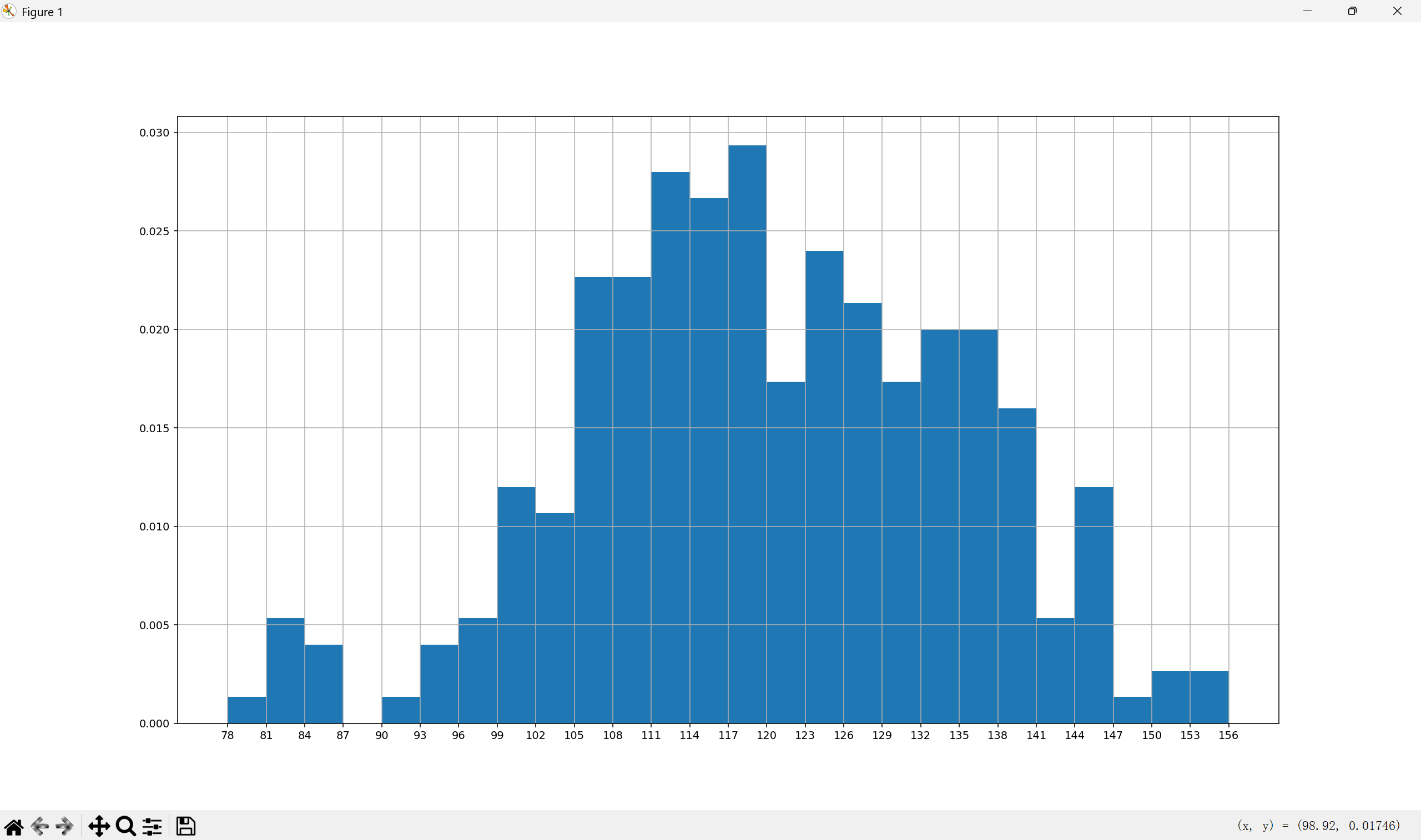
Q2:在美国2004年人口普查发现有124 million的人在离家相对较远的地方工作。根据他们从家到上班地点所需要的时间,通过抽样统计(最后一列)出了下表的数据,这些数据能够绘制成直方图么?
interval = [0,5,10,15,20,25,30,35,40,45,60,90]
width = [5,5,5,5,5,5,5,5,5,15,30,60]
quantity = [836,2737,3723,3926,3596,1438,3273,642,824,613,215,47]
from matplotlib import pyplot as plt
from matplotlib import font_manager
my_fount = font_manager.FontProperties(fname="C:/WINDOWS/FONTS/MSYHL.TTC")
interval = [0,5,10,15,20,25,30,35,40,45,60,90]
width = [5,5,5,5,5,5,5,5,5,15,30,60]
quantity = [836,2737,3723,3926,3596,1438,3273,642,824,613,215,47]
plt.figure(figsize=(20,8),dpi=80)
plt.bar(range(len(quantity)),quantity,width=1)
_x = [i-0.5 for i in range(len(quantity)+1)]
_xl = interval+[150]
plt.xticks(_x,_xl)
plt.grid(alpha=0.5)
plt.show()
输出内容:
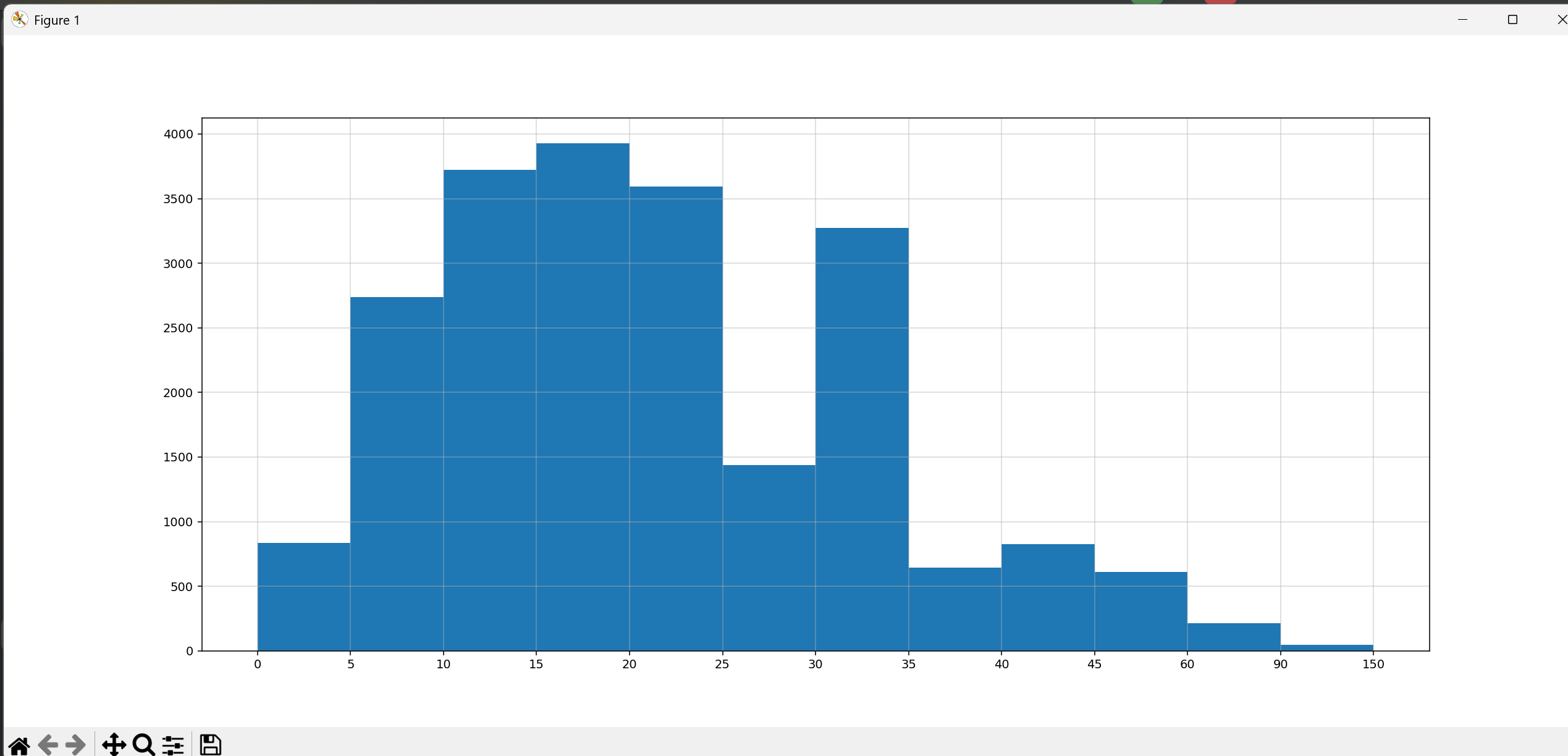

comment 评论区
star_outline 咱快来抢个沙发吧!